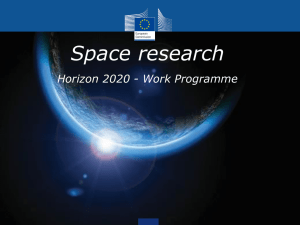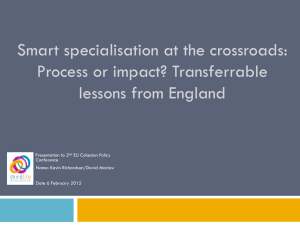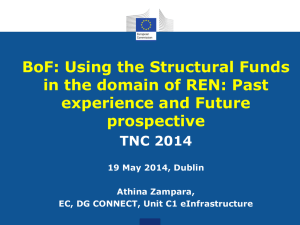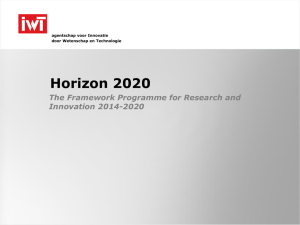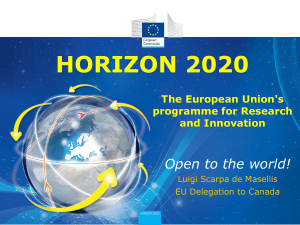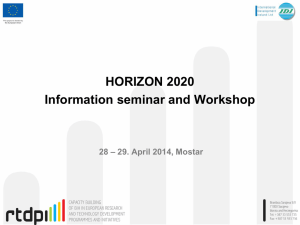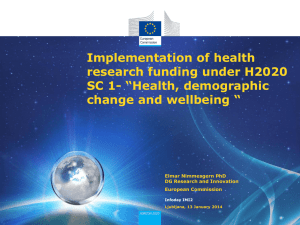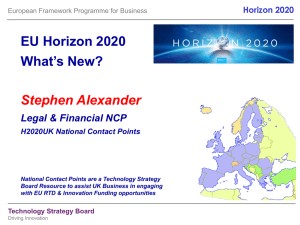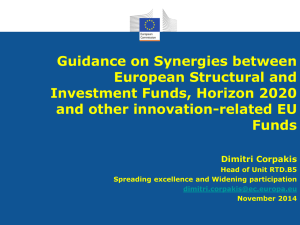Horizon 2020 ESIF
advertisement
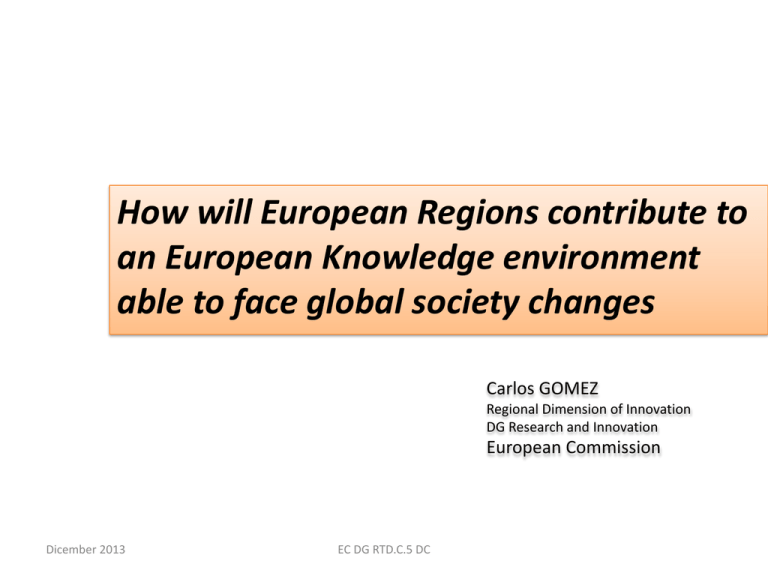
How will European Regions contribute to an European Knowledge environment able to face global society changes Carlos GOMEZ Regional Dimension of Innovation DG Research and Innovation European Commission Dicember 2013 EC DG RTD.C.5 DC Future Cohesion Policy 2014-2020 Consequences: 1. Thematic concentration to maximise the impact of investments 2. Conditionalities and strengthened partnership to ensure effective implementation 3. Common Strategic Framework: coherence across funds (ERDF, ESF, CF, EAFRD, EMFF); clarify synergies with Horizon 2020 etc. 4. Novelties – compared to current regulations The need for Synergies with the ESIF EU R&D Policy – future Horizon 2020 EU Cohesion Policy Differences non-territorial approach, no pre-defined geographical distribution of funding Based mainly on individual R&D Projects (to a certain extent also co-funding activities of programmes are supported) tackling the whole cycle of innovation from pre-competitive, leading edge basic research to demonstration projects, pilot activities, market replication as well as innovative public procurement and the award of prizes for the achievement of pre-specified targets. In general awarded directly to final beneficiaries like firms, public and private R&D centers, universities or research funding organisations (for ERA-net activities, Joint Programming etc.). Mostly competitive calls addressed to international groupings (exception ERC and MC that also address individuals) through peer-review based on excellence criteria place-based approach; defined financial envelope for different eligible categories of regions Based on multiannual Programmes aiming at increased competitiveness through close to the market competitive R&D and innovation efforts Awarded through shared management to national and regional public intermediaries Mostly non-competitive attribution addressed to regional players based on strategic planning negotiation (however increasingly competitive processes at national or regional level) Complementarities Horizon 2020 will focus on tackling major societal challenges, maximising the competitiveness impact of research and innovation and raising and spreading levels of excellence in the research base Cohesion policy will focus on galvanising smart specialisation that will act as a capacity building instrument, based on learning mechanisms and the creation of critical skills in regions and Member States. One of the expected results will be better ability to participate in Horizon 2020. Keys to Synergies Smart Specialisation ex-ante conditionality Thematic Concentration sustainable inclusive Europe 2020 smart Thematic objectives 1. 2. 3. 4. 5. 6. 7. Research and innovation Information and Communication Technologies Competitiveness of Small and Medium-Sized Enterprises (SME) Shift to a low-carbon economy Climate change adaptation and risk management and prevention Environmental protection and resource efficiency Sustainable transport and disposal of congestion on major network infrastructure 8. Employment and support for labour mobility 9. Social inclusion and poverty reduction 10. Education, skills and lifelong learning 11. Increased institutional capacity and effectiveness of public administration The Synergies and Smart Specialisation Matrix STRUCTURAL FUNDS THEMATIC OBJECTIVE NO 1 ON STRENGTHENING RESEARCH, TECHNOLOGICAL DEVELOPMENT AND INNOVATION HORIZON 2020 TOP DOWN RESEARCH AND INNOVATION PRIORITIES INFLUENCING NATIONAL AND REGIONAL PRIORITIES THEMATIC CONCENTRATION FOR MOST ADVANCED AND TRANSITION REGIONS FOR ALLOCATING 80% OF THE ERDF MONEY FOR 4 OBJECTIVES: R&I, ICT, SME COMPETITIVENESS AND LOW CARBON ECONOMY EXCELLENCE SMART SPECIALISATION EX-ANTE CONDITIONALITY INDUSTRIAL LEADERSHIP SOCIETAL CHALLENGES THEMATIC CONCENTRATION FOR LESS ADVANCED REGIONS FOR ALLOCATING 50% OF THE ERDF MONEY FOR 4 OBJECTIVES: R&I, ICT, SME COMPETITIVENESS AND LOW CARBON ECONOMY based on a SWOT analysis to concentrate resources on a limited set of research and innovation priorities in compliance with the NRP; measures to stimulate private RTD investment; a monitoring and review system; a framework outlining available budgetary resources for research and innovation; a multi-annual plan for budgeting and prioritisation of investments linked to EU research infrastructure priorities (European Strategy Forum on Research Infrastructures ESFRI) Billion EUR Less developed regions 164.3 Transition regions 31.7 More developed regions 49.5 Cohesion Fund 66.4 European territorial cooperation 8.9 Of which Cross border cooperation 6.6 Transnational cooperation 1.8 Interregional cooperation 0.5 Outermost regions and northern sparsely populated regions 1.4 Youth Employment initiative 3.0 TOTAL 325.1 "Up-stream" "Down-stream" ESIF Horizon 2020 €80-100 billion € 70 billion "Staircase to Excellence" National/Regional R&I systems Capacity Building "Research Excellence" Research & Development Hopefully also excellence, but "Innovation Excellence" Innovation Market Synergies in practice • Responsibility lies now with the Member States and regions’ planning authorities > need to create the appropriate “space” in the Operational Programmes for synergy actions with Horizon 2020 • The Commission prepares a concise Guide on Synergies Horizon 2020 marks a departure in terms of support to regional innovation Focus is on institutions, companies and people, not on regions…. However: Novelties such as new financial engineering instruments, the new SME instrument and the Fast Track to innovation pilot may have a strong and lasting effect at regional level Spreading excellence and widening participation through Horizon 2020 • New Part III-a in Horizon 2020 (budget circa EUR 800M) • Main actions on Teaming (Centres of Excellence), Twinning (institutional networking), ERA Chairs (bringing excellence to institutions); also Policy Support Facility and a special action from COST on Widening actions Combining public funding sources for ambitious industrial projects What is combined funding? Combined funding is the possibility to use different public funding sources, including EU funding sources, within a programme, project or a group of projects. It seeks to exploit complementarities and synergies while at the same time needs to avoid overlaps and exclude double-financing. Combining EU funding sources H2020 and ESIF – Legal basis: The H2020 Rules for Participation (Article 31) and for the Common Provisions Regulation on the ESIF (Article 55(8)) both deviate from the Financial Regulation (Article 129) as they allow for the funding of the same action by two different instruments, subject to the absence of double funding. Potential cases of combining Horizon 2020 & ESIF Two potential cases of combined funding for the same industrial project 1. Simultaneous / additional / parallel use of funds for the same industrial project: the simultaneous use of different public funding sources in the same industrial project e.g. H2020 money and ESIF that are used together to fund different cost items within a single industrial project 2. Sequential funding for the same industrial project: the sequential use (in time) of different public funding sources in separate successive subprojects of the same industrial project e.g. first ESIF for R&I infrastructure, then Horizon 2020 for innovation activities Basic budgetary principles 1. "non-substitution principle" The use of a Union funding instrument to substitute the non-Union contribution to another Union instrument is not allowed: ESIF cannot be used to substitute the national or private contribution to H2020 projects. Substitution of a non-Union contribution (eg. to a Horizon 2020 project) with Union funding (eg. ESIF) is not possible 2. "no double funding principle" It will be possible to award a grant under Horizon 2020 for an industrial project which is also funded by an ESIF grant but the absence of double funding should be ensured. The two Union grants (Horizon 2020 and ESIF) may not cover the same cost item. Combining Horizon 2020 & ESIF for ambitious industrial project Define scope of industrial project (incl. beneficiaries), detailed activities, budget (private/public) Look at eligibility of activities: localisation (e.g. region), type of cost items (e.g. equipment) in combination with beneficiaries and timeline Prepare financial master plan for industrial project: group activities in projects (=set of cost items for certain beneficiaries), identify costs and funding options for each (ESIF, H2020, national funds,…), contact Managing Authorities,… Prepare H2020 proposal (project & consortium) =>self-standing multi-national project Prepare ESIF proposal (projects + beneficiaries) for each region/country involved taking into account Smart Specialisation Strategies Submit H2020 and ESIF proposals including master plan for industrial project) Combining Horizon 2020 & ESIF for ambitious industrial projects Example: Industrial project with combined funding from Horizon2020 & ESIF Industrial project description (master plan) Work packages (ideally geographically attributable) and definition of cost items Horizon2020 proposal and budget Incl. public or private cofunding … But no ESIF! ESIF proposal and budget Incl. public or private cofunding + specifying which Operational Programme will co-fund and where … But no Horizon 2020! Example: Industrial project with combined funding from Horizon2020 & ESIF ESIF MS/region Horizon 2020 Industrial project Horizon 2020 + public/ private cofunding ESIF of MS/reg + public/private cofunding Combining Horizon 2020 & ESIF for ambitious industrial projects Example : Industrial project with combined funding Horizon 2020 proposal to be delivered: • Industrial project description (master plan including information on parts depending on other financial sources) (*) • Horizon 2020 part => self-standing grant agreement (*) Modalities on sort of proof for existence of other funding sources being worked out Combining Horizon 2020 & ESIF for ambitious industrial projects Example : Industrial project with combined funding Evaluation Horizon 2020 Evaluators: look into this to appreciate the entire project … and negotiate this part of the budget. Industrial project description (master plan) Work packages (ideally geographically attributable) and definition of cost items Horizon2020 proposal and budget Incl. public or private cofunding … But no ESIF! ESIF proposal and budget Incl. public or private cofunding + specifying which OP will co-fund and where… But no H2! ESIF Managing Authority: … look into this to appreciate the entire project and looks into this part of the budget and checks the eligibility of the type of proposed costs, the location of the operation, etc. Learn more: www.ec.europa.eu/horizon2020 http://ec.europa.eu/regional_policy/index_fr.cfm Thanks a lot for your attention

